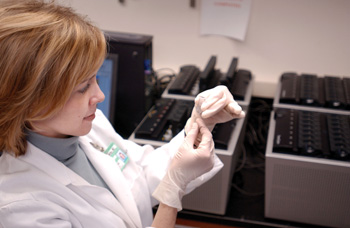
Kathryn Miller, M.D., is studying the role rhinoviruses play in pediatric hospitalization rates, especially for children who have a history of asthma. (photo by Susan Urmy)
Study tracks cold’s impact on pediatric hospitalization rates
A new study reveals that children are hospitalized more frequently with breathing problems that can be tied to the common cold virus than previously thought.
Kathryn Miller, M.D., M.P.H., a fellow in the Division of Pediatric Allergy, Immunology, and Rheumatol-ogy, is first author on the study, published in the Journal of Infectious Diseases.
Miller said that, while rhinoviruses — the primary contributor to the common cold — have been seen by some as relatively benign, this study shows they can be an important cause of hospitalization in young children.
Miller used a large database of nasal swabs of children who were hospitalized at the Monroe Carell Jr. Children's Hospital at Vanderbilt and a hospital in Rochester, N.Y., as part of the New Vaccine Surveillance Network (NVSN) with the Centers for Disease Control and Prevention (CDC).
Of the 592 children less than 5 years of age who were diagnosed with respiratory illness or fever, 26 percent had a rhinovirus. Children with a history of wheezing or asthma were eight times more likely to be hospitalized with a rhinovirus as those without a history of asthma. And the children with a history of asthma accounted for almost half (48 percent) of all the hospitalizations associated with rhinoviruses.
“The number of children hospitalized with breathing problems associated with rhinoviruses was even larger than the number who tested positive for RSV (respiratory syncytial virus),” said Miller. RSV is considered the leading cause of breathing problems that lead to hospitalization of infants.
“With better testing methods, we've been able to show that rhinoviruses may be as important a cause of hospitalization, especially for children who have a history of asthma.”
What has been well documented is that rhinoviruses are the single largest contributor to the common cold, causing more than half of all instances. The bigger question is whether a certain few types of rhinovirus (out of more than 100 types) are more apt to cause severe symptoms than other types, or if a vaccine could be developed for children who have a history of wheezing, to avoid hospitalizations during cold season.
"This study shows that rhinoviruses are associated with hospitalizations for fever and respiratory illnesses, even in young infants," said Miller. “The next steps are to see if our results can be duplicated, and then to sequence the genes from our virus samples and 'serotype' the strains that may cause more severe symptoms. Patients with asthma might be particularly good candidates for prevention and treatment strategies for rhinovirus infection,” Miller said.













